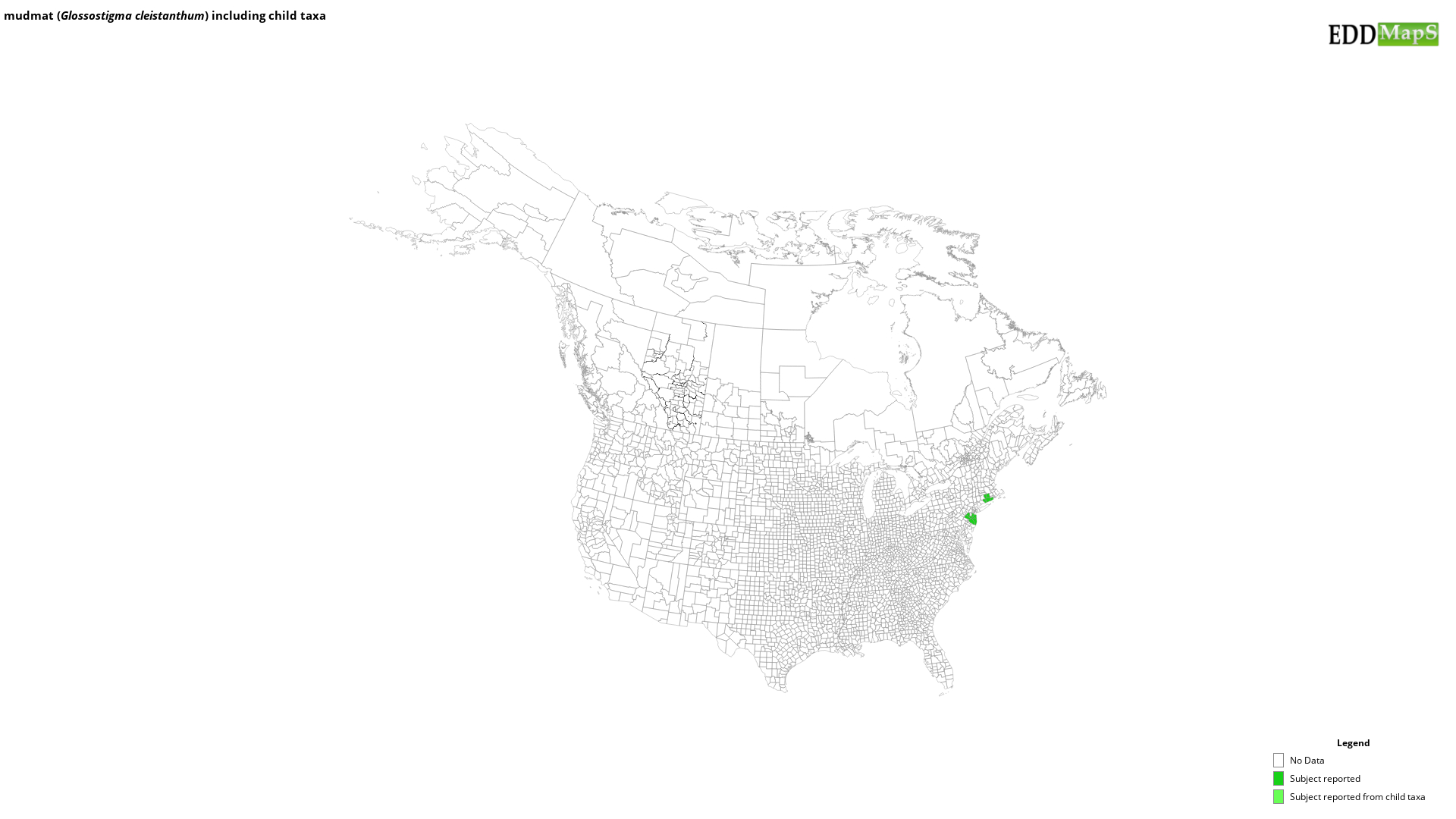mudmat
(Glossostigma cleistanthum)
This species is Introduced in the United States
ORIGIN: Australia, New Zealand
GROWTH TRAITS: Small herbaceous, aquatic that is anchored to the sediment by a rhizomatous root system. Plants grow either submerged in freshwater or emergent along shorelines. Rhizomes grow just below the soil surface and produce roots and two leaves at each node. Leaves are bright green, 0.4-1.2" (1-3 cm) long, and spatula-shaped with rounded tips and smooth margins. Flowers are produced throughout summer. Flowers on emergent plants are tiny, bell-shaped, and pinkish-white. They appear on slender stalks arising from rhizome nodes. On submerged plants, closed, self-fertilized flowers (cleistogams) are produced at rhizome nodes. Fruits are small capsules containing numerous tiny seeds. Emergent plants grow as annuals, dying back in the winter. Submerged plants are perennial, remaining green and producing fruit throughout winter.
REPRODUCTION: Spreads by seed and rhizomes. Seed longevity is unknown.
HABITAT: Grows submerged or along sandy to muddy shorelines of freshwater lakes and rivers and fresh tidal reaches. When growing submerged, the clarity of the water determines its depth. It is typically restricted to shallow water but has been found 13' (4 m) deep in very clear water.
LOOK-ALIKES: The small, spatula-shaped leaves and tiny whitish flowers of mudmat resemble those of native mudwort species, including water mudwort (Limosella aquatica). Water mudwort differs by having multiple leaves per plant (node), larger leaves, and flowers with 5 petals. Emergent leaves of some bladderwort species (Utricularia) may be confused for mudmat. Bladderworts can be differentiated by having larger yellow flowers.
CITATIONS:
Rawlins, K.A., R.L. Winston, C.T. Bargeron, D.J. Moorhead, and R. Carroll. 2018. New Invaders of the Northeast and Northcentral United States. USDA Forest Service, Forest Health Assessment and Applied Sciences Team, Morgantown, West Virginia. FHTET-2017-04. Retrieved from https://bugwoodcloud.org/resource/pdf/FHTET-2017-04_New%20Invaders_NE.pdf
GROWTH TRAITS: Small herbaceous, aquatic that is anchored to the sediment by a rhizomatous root system. Plants grow either submerged in freshwater or emergent along shorelines. Rhizomes grow just below the soil surface and produce roots and two leaves at each node. Leaves are bright green, 0.4-1.2" (1-3 cm) long, and spatula-shaped with rounded tips and smooth margins. Flowers are produced throughout summer. Flowers on emergent plants are tiny, bell-shaped, and pinkish-white. They appear on slender stalks arising from rhizome nodes. On submerged plants, closed, self-fertilized flowers (cleistogams) are produced at rhizome nodes. Fruits are small capsules containing numerous tiny seeds. Emergent plants grow as annuals, dying back in the winter. Submerged plants are perennial, remaining green and producing fruit throughout winter.
REPRODUCTION: Spreads by seed and rhizomes. Seed longevity is unknown.
HABITAT: Grows submerged or along sandy to muddy shorelines of freshwater lakes and rivers and fresh tidal reaches. When growing submerged, the clarity of the water determines its depth. It is typically restricted to shallow water but has been found 13' (4 m) deep in very clear water.
LOOK-ALIKES: The small, spatula-shaped leaves and tiny whitish flowers of mudmat resemble those of native mudwort species, including water mudwort (Limosella aquatica). Water mudwort differs by having multiple leaves per plant (node), larger leaves, and flowers with 5 petals. Emergent leaves of some bladderwort species (Utricularia) may be confused for mudmat. Bladderworts can be differentiated by having larger yellow flowers.
CITATIONS:
Rawlins, K.A., R.L. Winston, C.T. Bargeron, D.J. Moorhead, and R. Carroll. 2018. New Invaders of the Northeast and Northcentral United States. USDA Forest Service, Forest Health Assessment and Applied Sciences Team, Morgantown, West Virginia. FHTET-2017-04. Retrieved from https://bugwoodcloud.org/resource/pdf/FHTET-2017-04_New%20Invaders_NE.pdf
Selected Images
Maps
EDDMapS Distribution - This map is incomplete and is based only on current site and county level reports made by experts, herbaria, and literature. For more information, visit www.eddmaps.org
State Lists - This map identifies those states that have this species on their invasive species list or law.
Invasive Listing Sources
- Mid-Atlantic Field Guide to Aquatic Invasive Species
- National Park Service, Mid-Atlantic Exotic Plant Management Team Invasive Plant List
- National Park Service, National Capital Region Exotic Plant Management Team Invasive Plant List
- New Invaders of the Northeast and Northcentral
- New Jersey Invasive Species Strike Team 2017 Invasive Species List
- Pennsylvania's Field Guide to Aquatic Invasive Species
- Rhode Island Natural History Survey
- To be proposed for MISC
- Wisconsin Noxious Weeds
- Wisconsin's Invasive species rule – NR 40
Taxonomic Rank
| Domain: Eukarya |
| Kingdom: Plantae |
| Phylum: Magnoliophyta |
| Class: Magnoliopsida |
| Superorder: Asteranae |
| Order: Lamiales |
| Family: Scrophulariaceae |
| Genus: Glossostigma |
| Glossostigma cleistanthum |
References
Common Name Reference: Derived from taxonomy / Generic common name
Scientific Name Reference: The Plant List (2010). Version 1. Published on the Internet; http://www.theplantlist.org/ (accessed 1st January).


